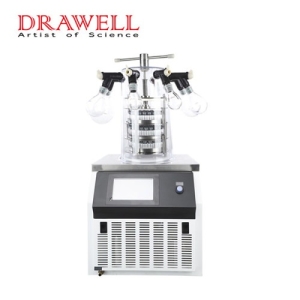Autoclaves, in their most basic form, are pressure chambers that are utilized in a wide variety of scientific and industrial processes, on both a small and a large scale. These processes include sterilization, drying, and aeration, among others. The steps of sterilization, drying, and heating are included in these processes. These chambers can be put to use in a wide variety of processes, including the hydrothermal synthesis, the curing of composite materials, and the sterilization of microorganisms, to name just a few examples. A change in the machine's capabilities is brought about by the myriad of tasks that are performed on it. These conditions are achieved with the assistance of an increased pressure that is applied, as well as with the help of steam. The waste materials, whether solid or liquid, are put through a process of sterilization in the pressure chamber so that they can be used in sterile applications like medicine, surgery, and scientific research. These applications require a sterile environment. Even though sterilization has been the primary purpose of autoclaves for as long as anyone can remember, different industries have different requirements for the types of autoclave supplier that must be used and the dimensions that they must have. The following are some examples of types that are among the most commonly seen:
The sterilization of medical equipment in horizontal autoclaves is accomplished through the use of gravity displacement, which necessitates the autoclave to be of a very large size. The autoclave that belongs to this category can be described as being horizontal.
These specific kinds of high pressure autoclave are known as media preparers, and they are utilized for the purpose of preparing and sterilizing a wide variety of microbiological media under a variety of different conditions.
Autoclaves of the pass-through variety are the kinds of autoclave supplier that are used in situations within industries where the prevention of contamination and the maintenance of a secure environment continue to be primary concerns. Pass-through autoclaves are the kinds of autoclaves that are used. By utilizing autoclaves, the materials can be moved from the laboratory to the outside environment in a way that does not expose them to any risks and does not expose them to any contaminants.
The most common applications for vertical vertical autoclave are those that require sterilization in a laboratory setting. These are also the applications that use vertical autoclave supplier the most.
Examples and Applications of Autoclaves in the Commercial and Industrial Sectors
The sterilization and disinfection of solid (instruments, glassware, pipettes), liquid (culture media and nutrient), and biological wastes (solid waste in destruction bags or liquid waste in a bottle, etc.) is one of the most common applications for autoclaves in laboratories. Other applications include the preparation of culture media and nutrients.
Autoclaves are common pieces of equipment used in the aerospace industry, and the process of curing composite aircraft parts typically involves using autoclaves. In addition, because of developments in technology, Vertical autoclave are now used in the production process of specific components of large aircraft, such as the fuselage and the wings. This is the case because these components require a particularly high level of precision during the manufacturing phase.
The use of as an essential piece of equipment is required in order to produce premium and high-quality synthetic quartz crystals, which are utilized in the electronica industry. This is because these crystals are used in the production of electronica.
The use of vertical autoclave is an activity that carries with it an inherent risk because of the nature of the device.
Because they have performed preventative maintenance on an autoclave, Duraline is able to provide a certification label for that autoclave when it is subjected to an inspection. This is possible because the autoclave was previously maintained by Duraline. When an autoclave is being inspected, this certification label is a requirement that needs to be met in order to pass.
The manufacturers of autoclaves recommend that preventative maintenance be performed anywhere from once every six months to once every twelve months, depending on the make/model of the autoclave or how frequently it is used. The frequency of the maintenance varies based on how often the autoclave is used. The number of times the autoclave needs to be maintained is proportional to the number of times it is used. Autoclaves that are considered to be at the cutting edge of technology, such as the Tuttnauer EZ9Plus and EZ11Plus, are constructed with an LCD screen that notifies users when it is time to perform a routine maintenance check. This screen is installed on the control panel of the autoclave and is a standard feature on these autoclaves.
In the same way that it is necessary to change the oil in a car on a regular basis and take the vehicle in for annual services, it is also necessary to properly maintain an autoclave in order to ensure that the device lasts as long as it should for as much of its expected lifespan as it possibly can.
Preventative maintenance ensures:
Throughout the entirety of the process, the autoclave will be run at its highest possible capacity continuously.
During each and every cycle of the process, the instruments are subjected to the appropriate level of sterilization.
The total number of calls that have been placed to various emergency services has dropped by a sizeable amount.
As a direct result of this adjustment, not only the patients but also the staff are in a safer situation. The individuals listed below are some examples of biotechnicians:
It is of the utmost importance that each of the components—the door, the trays, the reservoir, and the chamber—be meticulously cleaned.
Perform a thorough cleaning of the condenser coils, as well as an inspection of the sensors and valves, and then return the system to working order.
Conducting routine maintenance checks and inspections on electrical equipment and putting them through their paces on a regular basis.
Provide a comprehensive service report
It is important to remember to replace the filters and gaskets whenever they become worn or damaged.
Verify that the temperature is correct, proceed with the test, and make any necessary alterations to the calibrating settings on the sterilizer.
View maintenance plans
In what specific ways are the members of the staff responsible for ensuring that the space is kept clean?
Weekly
Cleaning the autoclave chamber (also known as the StatIM cassette), the trays, and the door gasket once every week requires the use of a gentle detergent and water, followed by a thorough rinsing.
When you are descaling the chamber, copper tubes, and reservoir of the autoclave, you need to make sure that you use the descaler that is designed specifically for autoclaves.
When working with StatIMs, you should coat the inside of the cassette with Stat-Dri after every ten cycles. This will prevent moisture from building up inside the cassette. In addition to this, you need to make sure the safety valve is working properly and clean the strainer that is situated inside the chamber. At the very end, you need to clean the rack, the trays, and the chamber by washing them with water.
Seven and a half months
During the drying cycle, it is necessary to periodically replace the HEPA air filters that are installed in the StatIM's and Tuttnauer autoclaves in order to ensure that a sufficient amount of clean air is being supplied. This is done for the same reason that it is necessary to periodically replace the filters that are installed in the Tuttnauer autoclaves. When it comes to StatIMs, the air filter, the cassette seal, and the biological air filter all need to be replaced after every 500 cycles or every six months, whichever comes first. This is to ensure that the device continues to function properly. It makes no difference which frequency arrives first; this is always the case.
A duration of twelve months
It is recommended that the door gasket be replaced once a year, or more frequently if necessary. However, it can be done less frequently if necessary. On the other hand, this is something that should be done according to your own judgment.
menu
menu
Menu
close
- homeHome
- arrow_backarrow_drop_downaccount_circlePeople
- arrow_backarrow_drop_downchatChat Time
- arrow_backarrow_drop_downvideocamMeetings
- Go Live
- arrow_backarrow_drop_downGift card & Top ups
- arrow_backarrow_drop_downnewspaperNews
- arrow_backarrow_drop_downbusinessProperties
- arrow_backarrow_drop_downwork_historyJobs Search Engine
- arrow_backarrow_drop_downstorefrontStores
- arrow_backarrow_drop_downlibrary_musicMusics
- arrow_backarrow_drop_downMore


